Living When a Young Friend Commits Suicide
Selected Other Books by Earl A. Grollman
Bereaved Children and Teens: A Support Guide for Parents and Professionals (editor)
Caring and Coping When Your Loved One Is Seriously Ill
Concerning Death: A Practical Guide for the Living (editor)
Explaining Divorce to Children (editor)
In Sickness and in Health: How to Cope When Your Loved One Is Ill
Living When a Loved One Has Died
Straight Talk about Death for Teenagers: How to Cope with Losing Someone You Love
Suicide: Prevention, Intervention, Postvention
Talking about Death: A Dialogue between Parent and Child
Talking about Divorce and Separation: A Dialogue between Parent and Child
The Working Parent Dilemma (with Gerri L. Sweder)
Time Remembered: A Journal for Survivors
What Helped Me When My Loved One Died
When Someone You Love Has Alzheimers: The Caregivers Journey (with Kenneth S. Kosik, M.D.)
When Your Loved One Is Dying
Your Aging Parents: Reflections for Caregivers (with Sharon Grollman)

Beacon Press
25 Beacon Street
Boston, Massachusetts 02108-2892
www.beacon.org
Beacon Press books
are published under the auspices of the Unitarian Universalist Association of Congregations.
1999 by Earl A. Grollman and Max Malikow
All rights reserved
Printed in the United States of America
12 11 10 09 08 9 8 7 6 5 4
This book is printed on recycled acid-free paper that contains at least 20 percent postconsumer waste and meets the uncoated paper ANSI/NISO specifications for permanence as revised in 1992.
Text design by Preston Thomas
Composition by Wilsted & Taylor Publishing Services
Library of Congress Cataloging-in-Publication Data
Grollman, Earl A.
Living when a young friend commits suicide or even starts talking about it / Earl A. Grollman and Max Malikow.
p. cm.
SUMMARY: Discusses why people commit suicide, how to deal with the various emotions caused by the suicide of someone you know, how to help someone suicidal, religious issues, and popular misconceptions about suicide.
ISBN 0-8070-2503-8
1. YouthSuicidal behaviorPsychological aspects Juvenile literature. 2. SuicidePsychological aspects Juvenile literature. 3. Teenagers and death Juvenile literature. 4. Bereavement in adolescence Juvenile literature. 5. Grief in adolescence Juvenile literature. [1. Suicide.] I. Malikow, Max. II. Title.
HV6546 .G76 1999
362.28'3'0835dc21 99-14820
In this life we will come across many obstacles on the long road to true happiness. There is responsibility which limits us, lies which mislead us, desire which distracts us, and love which sustains us.
Rachel Joy Malikow, age 13
Contents
I.
II.
III.
IV.
V.
VI.
VII.
VIII.
IX.
X.
One of your friends or relatives has committed suicide. Thats why you are reading this book. If we were with you, you could tell us about your friend. If we were with you, you could tell us how much this person meant to you. You could tell us what it feels like to have this person taken from you. You could tell us what youre thinking and ask us questions about suicide.
Since were not with you, weve written this book for you. In it we answer the questions youre likely to ask after a friend has committed suicide:
 Why did he kill himself?
Why did he kill himself?
 Could I have prevented it?
Could I have prevented it?
 Did I do anything to cause it?
Did I do anything to cause it?
 Was it really a suicide?
Was it really a suicide?
 Whose fault is it?
Whose fault is it?
 What am I supposed to feel?
What am I supposed to feel?
 Sometimes I feel depressed.
Sometimes I feel depressed.
 Could I commit suicide?
Could I commit suicide?
 Was she crazy?
Was she crazy?
 What happens to people when they die?
What happens to people when they die?
 Is suicide a sin?
Is suicide a sin?
 Is it wrong for me to feel angry?
Is it wrong for me to feel angry?
 Why do I feel guilty?
Why do I feel guilty?
 Why do people have to suffer so much that they kill themselves?
Why do people have to suffer so much that they kill themselves?
 How can I prevent another suicide?
How can I prevent another suicide?
 Is it o.k. to talk about his suicide?
Is it o.k. to talk about his suicide?
 Do a lot of people kill themselves?
Do a lot of people kill themselves?
 Why do people kill themselves?
Why do people kill themselves?
Although weve tried to be thorough perhaps weve not answered all of your questions or talked about all of the things that are on your mind. This is why weve included suggestions for people you can talk to and other books you can read.
As you read this book, it would be helpful for you to remember that recovering from the death of someone you care about is a process. When that death is a suicide, it takes even more time to recover. Eventually, your pain, confusion, and sadness will decrease. A suicide kills one person and wounds those who are left behind to mourn. Weve written this book to help you in your healing.
In this book, when we write friend, you may need to substitute brother, sister, or cousin. What weve written to those who have lost a friend also applies to you if youve lost a young relative.
This book is intended to help you by answering questions you have about your friends suicide. Probably, this book includes answers to questions you are not asking. Thats why weve designed this book so that it is not necessary to read it completely from beginning to end. Weve written it in such a way that you can go to the table of contents, find the parts of the book that interest you, and be helped by reading those parts.

The First Days after a Death:
What You May Feel
Maybe it was a friend who called you and began with, Youre not going to believe what happened! Maybe the principal of your school called an assembly and announced that he had very sad news to report. Perhaps your mother came into your bedroom, sat on your bed, and said, I have something to tell you. However it was, you will never forget how you heard that your friend committed suicide.
Grief is a feeling that includes other feelings. One person described his grief as cold, burning pain. A famous writer, C. S. Lewis, wrote, No one ever told me that grief felt so like fear. What are you feeling? Shock? Depression? Loneliness? Confusion? Panic? Anger? You may be having many strange, weird, and even contradictory reactions to the shocking news. You might even have gotten physically sick when you heard of your friends suicide.
Next page
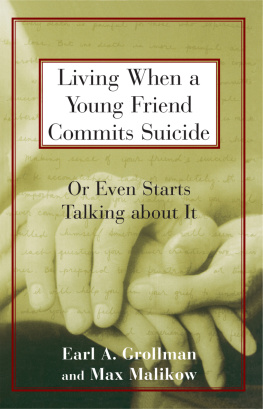
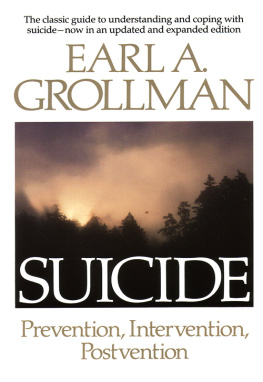
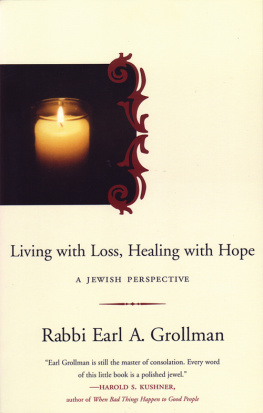
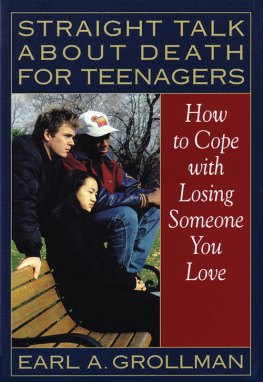
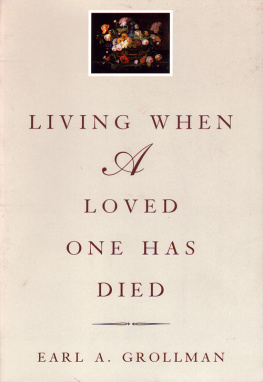

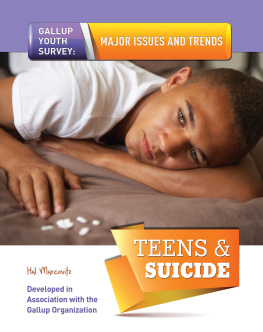


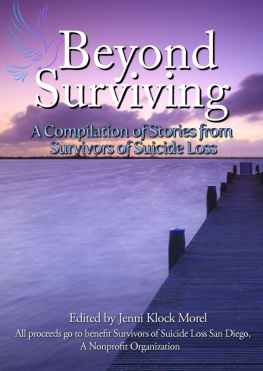
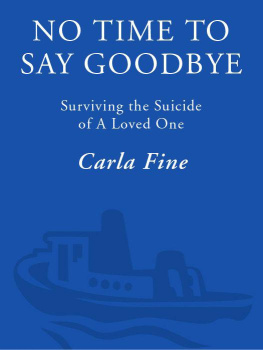

 Why did he kill himself?
Why did he kill himself?